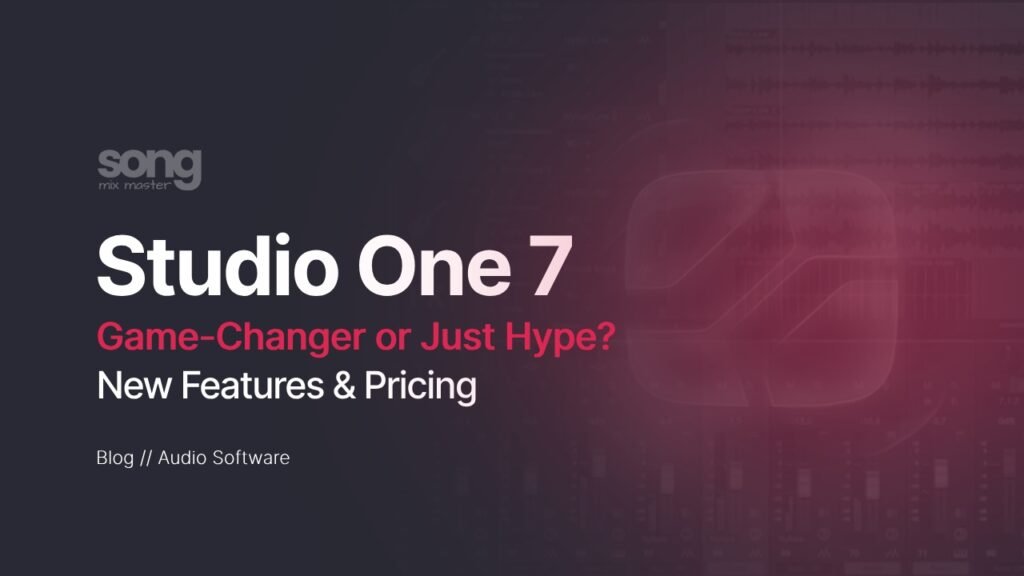Music Technology, Studio Setup
Presonus Studio One 7 Now Available: News & Features
Having produced, mixed, and mastered hundreds of tracks over the years, I’ve seen DAWs evolve from the days of Cool Edit, Audition, and Cubase to more recent favorites like FL Studio and Reaper. My journey with Studio One began with version 5, and it’s been a reliable tool thanks to its smooth workflow, solid stock plugins, and supportive community.
Now that Studio One 7 has officially launched as of October 9th (2024), I’ve been diving into its new features to see if this release lives up to the hype. Here’s what I think so far.
Studio One 7: What’s New?

Studio One 7 brings many new features, notably integrating advanced tools like AI-powered stem separation, expanded plugin compatibility with the CLAP format, and direct integration with Splice. The browser can now be detached, making it easier to use on a second monitor, a welcome change for multi-screen setups. Aesthetic improvements, like rounded event corners and customizable color schemes, are subtle but noticeable. Overall, the updates reflect a cleaner, more modern look and a smoother workflow.
For me, Splice integration with Studio One 7 is a standout. The ability to access Splice’s extensive sample library directly within Studio One without ever leaving the DAW is a game-changer. I can now easily find compatible sounds, sync them to my project’s tempo and key, and drop them right into the session.
Try the full Splice library free for 7 days
New Pricing and Licensing
PreSonus has streamlined the Studio One lineup with this release by discontinuing the Prime and Artist versions. Now, there’s just one edition: Studio One 7 Pro. This simplifies things for newcomers, as they get a full-featured DAW with all the essentials included. However, it’s a bittersweet change for long-time users like me who appreciated recommending the free Prime version to beginners.
Studio One 7 Pro now includes all extensions and virtual instruments, including the Presence XT Editor, Deep Flight One, and the Audio Batch Converter. This means access to some serious production tools right out of the box for new users.
A Step Forward or Backward?
Comparing this new pricing approach with other DAWs brings some interesting insights. Logic Pro, for instance, costs $199 but includes lifetime updates—a strong draw for Mac users. FL Studio’s lifetime updates are also appealing, allowing users to upgrade without additional fees. Meanwhile, Reaper offers incredible value at a fraction of the cost of most DAWs.
Studio One 7 remains competitive, though. Its intuitive design, drag-and-drop functionality, and stock plugins are strong selling points. With frequent updates now in the cards, Studio One could potentially bring new features faster than its competitors. But only time will tell if this new model wins over existing users and attracts newcomers in the face of more cost-effective alternatives.
Comparing Studio One to Other DAWs
Apple’s Logic Pro is one of the most affordable and feature-rich DAWs, available for a one-time payment of $199.99 (only for Mac users). Once purchased, users receive lifetime free updates, making it a desirable option for producers who want a professional-grade DAW without the hassle of yearly renewal fees. Similarly, FL Studio by Image-Line has a lifetime license, allowing users access to all future updates without additional costs.
Other DAWs like Reaper also provide significant value at a lower price point. These alternatives might make Studio One’s new pricing model less appealing to budget-conscious users.
That said, Studio One still stands out in its own right. Its intuitive workflow, drag-and-drop functionality, and powerful stock plugins have always been key selling points. Studio One 7 will continue to evolve faster with more frequent feature releases, which is exciting for users like me, who rely on its robustness and flexibility in professional settings.
Despite that, it remains to be seen whether the new pricing structure will retain users or attract new ones, especially given that competitors offer more appealing long-term value.
Final Thoughts
Studio One 7 is a compelling upgrade, especially for new users who can benefit from the lowered price and bundled extensions. The addition of Splice integration, stem separation, and a streamlined interface makes it more versatile and user-friendly. However, the yearly update model introduces a recurring cost that some may find off-putting, especially those accustomed to the old pricing structure.
For me, Studio One 7 feels like a fresh step forward. I’m optimistic about the new features and the potential for more frequent updates, but I also understand why some users might be wary of the pricing changes. PreSonus has certainly shaken things up, and I’ll be watching closely to see how this new approach plays out. In the meantime, I’ll continue exploring everything Studio One 7 offers and see how it holds up in my daily mixing and mastering sessions.


Disclaimer: Any references to any brands on this website/webpage, including reference to products, trademarks, brands and companies, are provided for description purposes only. We don't have any association with or endorsement by these brands or companies. Some of the links on our blog may be affiliate links. This means if you click on these links and make a purchase, we may earn a commission at no extra cost to you.
Check Out My New Fabfilter Pro-Q3 Presets Pack!
You may also like to read...
Top 5 Mistakes When Using Reverb in Audio Mixing
Should You Master Your Own Mixes? Pros and Cons
Harmonize Your Voice: 9 Essential Tips for Singing Better
How To Do Parallel Compression in FL Studio
Review of the Empirical Labs EL8 Distressor Plugin by UAD
Is Intel NUC 13 Pro the Best Mini PC for Audio Production?
Book My Mixing & Mastering Services